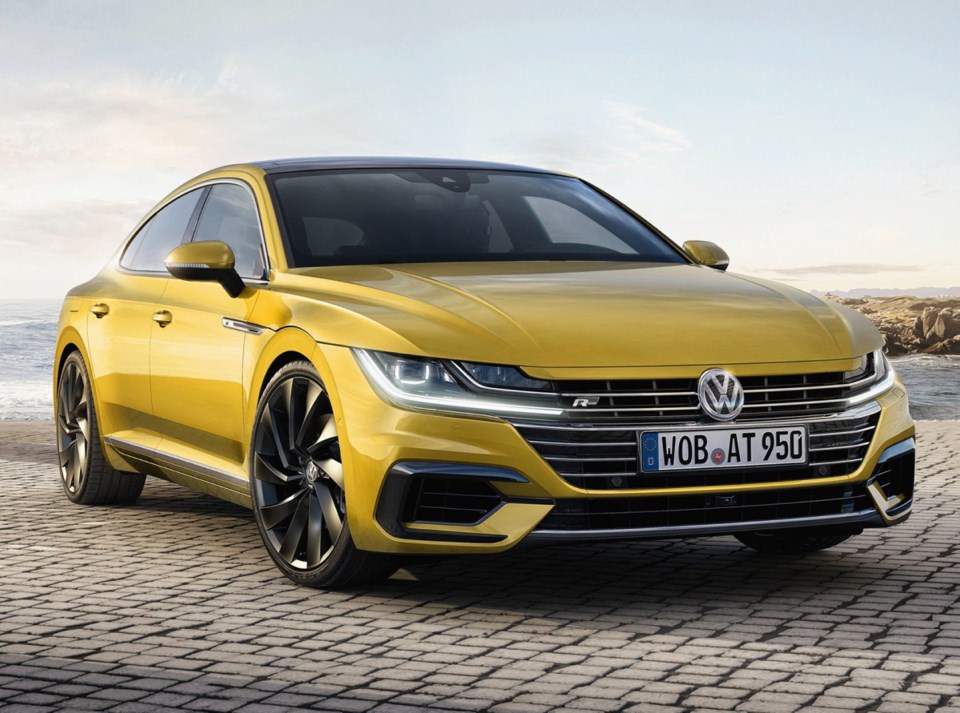Style and luxury often butt heads with practicality in the automobile world, but Volkswagen seems to have blended those traits into the 2019 Arteon.
And it’s a real looker.
The new four-door hatchback becomes the automaker’s prestige vehicle, by virtue of both its content and corresponding upper-range price.
Although similar in length to the Passat sedan and constructed on the same MQB platform (as are many other VW and Audi models), the Arteon follows its own distinctive design path. It also tops the Passat with nearly five centimetres more width and distance between the front and rear wheels, which increases rear legroom.
The low-slung look is somewhat reminiscent of VW’s CC sedan that was retired after 2017. That model was significantly smaller than the Arteon and had a trunk instead of a liftgate, which limited stowage capacity.
Fortunately, the Arteon’s designers had a larger canvas to literally and figuratively draw upon, and have generally succeeded in creating sufficient space — especially headroom — for four adults, or five in a pinch. Folding the 60:40 split rear seatback nearly flat can also expand the cargo area. Left in the upright position, a pass-through opening allows longer items to fit inside.
The sloping nose and hood add a degree of sportiness that the Passat lacks, while the fastback roofline compares with the Audi A5 Sportback and even the Kia Stinger.
In operational terms, the Arteon’s road-holding qualities are assisted by active dampers (shocks) that react in milliseconds to varying road conditions and driver inputs.
The cabin is pretty much a replica of the current Passat’s, especially the control panel and 20-centimetre touchscreen that are straightforward and easy to comprehend, which is the case with most VW models. The pushbuttons for the ventilation settings located below the touchscreen are on the small side, however.
Also seemingly small for the Arteon’s stature is the turbocharged 2.0-litre four-cylinder engine, although it makes a respectable 268 horsepower and 258 pound-feet of torque. The fuel-economy rating is 12.0 l/100 km in the city and 8.6 on the highway. It might seem odd that VW’s 3.6-litre V-6 isn’t on the menu, but it’s also no longer offered for the Passat.
An eight-speed automatic is your sole transmission choice, and it directs torque to all four wheels, since the Arteon is fitted with VW’s 4Motion all-wheel drive (which is not available in the Passat).
Arteon pricing begins at $49,900, including destination fees, for Exceline trim (the only one offered). That price gets you tri-zone climate control, 12-way power front seats (with massage function for the driver’s chair) and heated, leather-covered front and rear seats and a 700-watt, 12-speaker premium audio system.
Also included is a panoramic sunroof, a navigation system and a 31-centimetre digital gauge and information display that can be configured according to driver preferences.
On the active-safety front, the Arteon comes with forward-collision warning, autonomous emergency braking and blind-spot warning.
Available is an R-Line package, consisting of metal interior pieces, a unique front end with gloss-black accents, a small rear spoiler and 20-inch wheels (18-inchers are standard).
You can also order a Driver Assistance Package, consisting of a surround-view camera plus parking assist and lane-keeping technology. The Arteon-exclusive Kurkuma Yellow Metallic paint (shown here) will set you back an extra $500.
As an upscale hatchback, the Arteon runs the risk of overlapping some Audi offerings (Audi is part of the Volkswagen group), such as the A5 Sportback. On the other hand, the hatchback’s youthful and sporty demeanour should help convey Volkswagen’s mission of creating a stylish and fun-to-drive larger car that’s as luxurious as it is practical.



